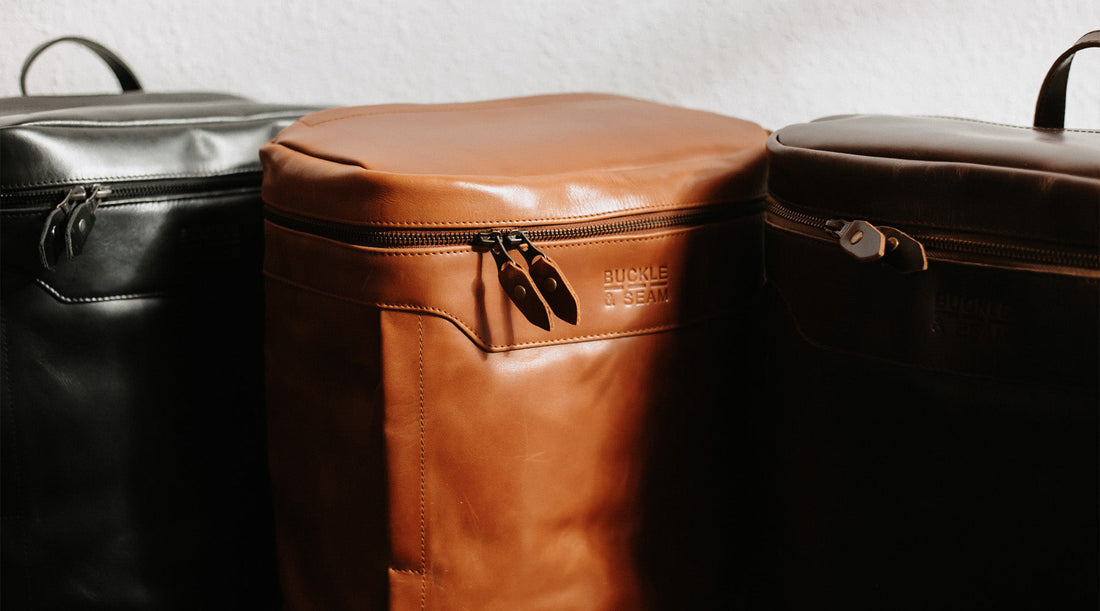
Vegetable-Tanned Leather: Why It Is the More Sustainable Choice
Why the hassle?
In an era where sustainability and quality are back in the spotlight, vegetable-tanned leather is experiencing a renaissance. Not only is it more environmentally friendly, but it also stands out for its natural feel, durability, and artisanal excellence. At Buckle & Seam, we are fully committed to vegetable tanning and natural dyeing methods – and for good reason. In this article, we’ll explain why vegetable-tanned leather is the more sustainable choice – for you, for the planet, and for future generations.
What Does “Vegetable-Tanned Leather” Mean?
Vegetable tanning is a leather-making process that uses natural tannins from sources like oak bark, mimosa bark, quebracho wood, or chestnut extracts. Unlike chrome tanning, which relies on aggressive chemicals such as chromium(III) salts, the vegetable method is far gentler – both for the environment and for your skin. This is not a modern trend: vegetable tanning has been practiced for thousands of years and is deeply rooted in traditional craftsmanship. The result is a character-rich leather with a natural appearance that develops a beautiful patina over time.
The Production Process in Detail
The process begins with carefully selected raw hides, preferably by-products of the meat industry. These hides are thoroughly cleaned and soaked for several weeks in pits or drums containing natural tannins. This slow process allows the leather to mature naturally. The dyeing stage follows – also without synthetic additives. Instead of chemical dyes, natural pigments such as indigo, turmeric, or walnut shells are used. This artisanal approach requires patience and skill, but the result is an exceptionally high-quality final product.
The Benefits of Vegetable-Tanned Leather
Vegetable-tanned leather excels in every way: Ecologically, it produces no toxic waste that could harm the environment. It is also better suited for allergy sufferers, as it contains no skin-irritating chemicals. Moreover, it is highly durable – instead of cracking or becoming brittle, it develops a unique patina over time. Finally, it is easier to recycle and, in some cases, even compost, making it not only beautiful but also a smart environmental choice.
The Social Responsibility Behind Vegetable-Tanned Leather
Choosing vegetable-tanned leather often means supporting better working conditions. At Buckle & Seam, for example, production takes place under fair conditions in Pakistan. Our entire supply chain is transparent and socially responsible. In addition, every purchase supports education projects: Through our #OneBagOneChild program, 3% of revenue is donated to the schooling of girls in Pakistan. For us, sustainability is not only about environmental care but also about social impact.
Why Vegetable-Tanned Leather Costs More – And Why It’s Worth It
The production of vegetable-tanned leather is complex, time-consuming, and requires expertise – all of which is reflected in the price. However, this higher price is an honest price: it represents quality, fair wages, eco-friendly processes, and longevity. Buying a vegetable-tanned leather product is a conscious choice against mass production and throwaway culture – and for appreciation, craftsmanship, and sustainability.
Vegetable Tanning vs. Conventional Leather Production
Unlike conventional chrome tanning, which creates toxic wastewater and is often carried out under questionable conditions, vegetable tanning is significantly more eco-friendly. While chemically tanned leather is often produced cheaply, it compromises quality and durability. Additionally, chemical residues pose health risks – both for tannery workers and end users. Vegetable-tanned leather, on the other hand, is a deliberate choice for quality, health, and environmental care.
Buckle & Seam Leather Products Under the Sustainability Lens
Our products stand for uncompromising quality and responsible practices. Each piece is handcrafted using only vegetable-tanned and naturally dyed leather. Our production partners meet the highest social and environmental standards, supported by certifications such as B Corp, Leather Working Group (LWG), and REACH. This ensures that our bags, backpacks, and accessories are not only durable and stylish but also come with peace of mind.
How to Care for Vegetable-Tanned Leather
To enjoy your leather product for many years, regular care with natural products is essential. Clean it with mild saddle soap and nourish it with a plant-based leather balm. Proper storage is equally important – keep it dry, ventilated, and away from direct sunlight. With proper care, your vegetable-tanned leather piece will last a lifetime and grow more beautiful over the years.
Conclusion – More Than Just a Fashion Trend
Vegetable-tanned leather is not a passing fashion but a conscious decision. It represents sustainability, quality, and social responsibility. Buying such a product means investing in a long-lasting piece with character – and taking a stand for a more responsible use of resources. At Buckle & Seam, we firmly believe that great design and ethical action can go hand in hand. With our vegetable-tanned leather goods, you can help make the world a little better, one bag at a time.
